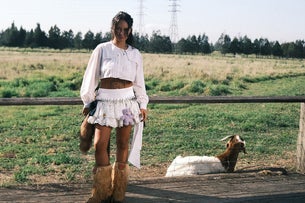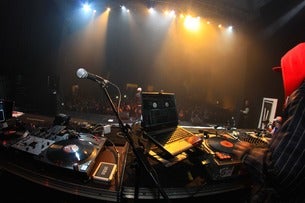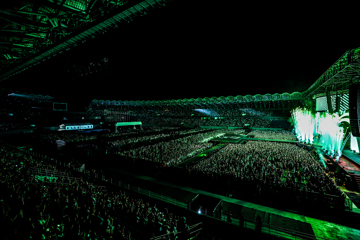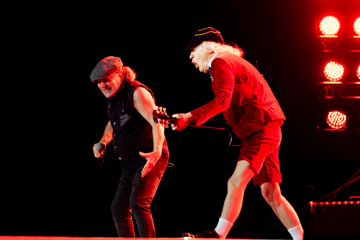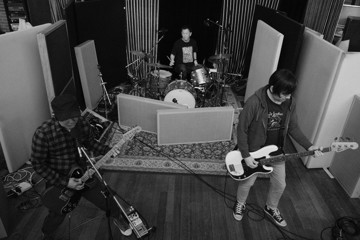Red, White & Green? Why It’s Important To Get Colours Right In Song Titles
We look at 15 songs where the use of another colour would have robbed it of its power.

The Beatles, Baker Boy, Chet Faker, Chappell Roan (Source: Supplied, Sulaiman Sully Enayatzada, Ryan Clemens)

How important is getting the right colour in a song to best convey its spirit?
Would Chris Martin’s transmitting the spectacle of the starry sky when coming out of Coldplay’s recording studio in Wales have had more impact if he’d gone for another colour than Yellow?
Would Taylor Swift’s Red have captured the same regret of an intense relationship going pfft – “like driving a new Maserati down a dead-end street” – if she’d called it Blue-Grey?
Here we look at 15 songs where the use of another colour would have robbed it of its power.
YELLOW SUBMARINE: THE BEATLES
Don't miss a beat with our FREE daily newsletter
On every album, The Beatles put a song aside for drummer Ringo Starr, which fitted his limited vocal range and his goofy popularity.
On the Revolver album with its acid experiments, Paul McCartney thought up a “heady” children’s song.
It would be based on an old mariner telling young kids about his life on the sea, with a singalong chorus. He imagined it’d be a submarine, and obviously a bright yellow one so as not to scare off its listeners.
The name also came from the yellow submarine dessert McCartney discovered on a Greek holiday. John Lennon threw in parts of a song he was working on. He identified with the title: he’d seen a yellow submarine on his first LSD trip.
PINK PONY CLUB: CHAPPELL ROAN
The song is about a small-time person coming to the big city and finding a safe space and being allowed to be who she wanted to be.
It was an autobiographical story for Chappell Roan, who in her hometown of Springfield, Missouri, had to suppress her identity. Arriving in West Hollywood in 2018, she stumbled into a gay bar called The Abbey, where for "the first time I could truly be myself and not be judged".
It was, to be expected, a life-changing moment for her.
Watching the go-go dancers "sparked [something] in me... I want[ed] to be a go-go dancer.” The title came from a real-life strip bar in Springfield, “that was in all hot pink", a colour she thought represented power in this context.
The song drools: “And I heard that there's a special place / Where boys and girls can all be queens every single day.”
BLUE STRIPS: JESSIE MURPH
Don’t get mad, get even. On Blue Strips, Jessie Murph got revenge on her cheating ex by flaunting her wealth. "I just bought a mansion in Malibu, you know how I get with an attitude."
In the song, which infused her trappy R&B pop with a country spice, she visits a strip club to find the dancer she believes her ex is unfaithful with.
"Yeah you got me throwing blue strips/ Bare tits/ In a strip club." In another line, "Throwing ones/ at your bitch” she’s tipping the dancers with $100 bills but just $1 at this girl to diss her.
"Blue strips" are the blue security strip found on American $100 bills. This is a metaphor for money and power, as well as revenge.
BROWN EYED GIRL: VAN MORRISON
The girl always had to have brown eyes. It was originally written as Brown Skinned Girl, about an interracial relationship a teenage Van Morrison presumably had, hence its calypso sounds.
It was thought Van Morrison changed the title not to upset southern US radio stations.
But he insisted the change was accidental. After recording it over two days and 22 takes, he put the tape into a box and tiredly labelled it Brown Eyed Girl.
"That was just a mistake… it just slipped my mind [that] I changed the title."
As it turned out, radio had a problem with the line “Making love in the green grass.” They replaced it with the more innocent "laughin' and a-runnin,' hey hey” from a previous verse.
It was a Top 10 smash and by 2011, had been played 10 million times on US radio. In January 2007 it was inducted into the Grammy Hall of Fame.
But Morrison seldom played Brown Eyed Girl onstage, shrugging, “I've got about 300 songs that I think are better.”
I SEE RED: SPLIT ENZ
Emerging on Split Enz’s 1979 Frenzy album, its writer, Tim Finn, thought red was the best hue for all the lyrical elements in the song.
In the Through The Eyes Of Love documentary, he explained: “It's a love song, because it's dealing with the passions and tensions and all the mental-ness that comes with trying to make it work with somebody ...
“I don't think it's really an angry song at all in a way — it's quite a celebratory thing ... You can sometimes be filled with rage and virtually hatred towards somebody who you actually love very much, but it's just gone again. And it's the letting go that's important.”
PINK SKIES: ZACH BRYAN
Pink Skies, the opening track of Zach Bryan’s fourth album The Great American Bar Scene, has many interpretations.
The opening line goes:
The kids are in town for a funeral
So pack the car and dry your eyes
I know they got plenty of young blood left in 'em
And plenty nights under pink skies
You taught 'em to enjoy
It could be about communal grief, and about his mum Annette DeAnn, who passed away in 2016 at 49. Bryan rejected this, saying it’s more about the strength of family relationships.
Following Bryan’s acrimonious split in October 2024 from the Plan Bri Uncut podcast presenter Brianna LaPaglia, Barstool Sports founder Dave Portnoy, who’d long had a beef with Bryan, sang on his diss track Country Diddy that the song was about LaPaglia’s podcast co-host Grace O'Malley.
When quizzed by a podcast listener, what could possibly be the connection between O’Malley and Pink Skies, LaPaglia responded, “Because I forced him to go to her grandma's funeral, he screamed at me then wrote it that night”.
Others suggested that the song came from the Biblical and sailor creed that a pink sky in the evening meant sunny the next day. That, from shared grief, a family reaches for better times.
BLUE MONDAY: NEW ORDER
That New Order wrote this in 1982 in a gloomy rehearsal room in Cheetham Hill in gloomy Manchester behind a gloomy graveyard explained why the lyrics were so unusual.
But that they were all on LSD at the time made it more melancholic and jumbled.
Singer/guitarist Bernard Sumner was most likely having a whinge about having to work so hard; his dislike of doing interviews indicated on “And still I find it so hard/To say what I need to say.”
Already, as per “I see a ship in the harbour/ I can and shall obey” he was dreaming about buying a sail ship and escaping. It was something he would actually do later when royalties rolled in.
Where did the title come from? Blue Monday was a US Top 5 in 1956 for R&B piano-plonker Fats Domino, and had also been a grumble-chunder about having to go back to work.
At the time of New Order’s writing the song, drummer Stephen Morris was reading Kurt Vonnegut 1973 novel Breakfast Of Champions. It had the phrase “Goodbye, Blue Monday”.
Keyboard player Gillian Gilbert explained: “It was a reference to the invention of the washing machine, which improved housewives’ lives.”
The track actually started life as a response to their fans’ grumbling that New Order didn’t do encores.
So they devised a plan where they’d walk off stage and a button would play the track to provide more music as the encore.
But in those pre-MIDI days, it didn’t fall into place, so they opted to make it into a song.
The track pioneered new technologies like samplers, drum machines and synthesizers (to learn how to use the sampler, Sumner and Morris spent hours recording their farts), took underground dance into the global mainstream, and remains a great picture book of ‘80s culture.
Blue Monday was later also the third Monday of January when people in the northern hemisphere were supposed to feel the most depressed in the whole year.
It was calculated on factors as weather conditions, post-Christmas debt and broken New Year resolutions.
It was absolute baloney, of course, but used in 2015 by English travel agency Sky Travel to encourage people to travel to sunny countries or go on cruises.
BLACK MAGIC: BAKER BOY
Not about voodoo, Baker Boy’s 2018 single Black Magic (featuring Dallas Woods) was sung in Yolngu Matha and English.
It was about the racism directed at First Nations athletes such as Cathy Freeman and AFL legend Nicky Winmar, and name-checked the Stolen Generation and Kevin Rudd’s apology.
Winmar’s now iconic moment of defiance – at a match between St Kilda and Collingwood in 1993 when he lifted his jumper to show his black skin as a response to racial taunts from some of the crowd – was also celebrated in Archie Roach’s 2013 track Colour of Your Jumper.
GOLD: CHET FAKER
In an interview with the Song Exploder podcast, Chet Faker’s creator Nick Murphy explained it was a love story, about the kind of explosive experience one is lucky to feel once or twice in a lifetime. Had to be gold.
PURPLE HAZE: JIMI HENDRIX EXPERIENCE
Purple Haze, which came in the psychedelia circles of 1967, is generally assumed to refer to what you get at the end of an LSD trip.
But Jimi Hendrix said it was actually from a dream he had about “walking under the sea”.
The song’s lyrics aren’t about that. But just before he went off to sleep, the ultimate guitar maestro had been reading the 1966 sci-fi novel Night Of Light by Philip José Farmer.
It was set on a distant planet whose inhabitants experienced a strange, world-altering haze every seven years. Writing about a planet with no time or space, he sang, “Is it tomorrow, or just the end of time?”
99 RED BALLOONS: NENA
When first recorded in their native German by Nena (name of the singer and the band), the song was called 99 Luftballons, or air balloons. They only went red in the English version.
The idea of the song came from two sources.
One was a 1973 article from the Las Vegas Review-Journal about five prankster high schools who sent off 99 aluminised Mylar balloons (originally 100 but one got lost) tied with ribbons to a traffic flare.
That gave it a red glow, and as they floated over the state of Nevada, people mistook them for a red UFO.
In June 1982, when Nena guitarist Carlo Karges attended a Rolling Stones show in Berlin, hundreds of helium balloons were released into the air at the end of the show.
Karges noticed they changed shapes like UFOs, and wondered what would happen if one of these drifted over the Berlin Wall into East Germany.
In the song, written by Karges and keyboard player Jörn-Uwe Fahrenkrog-Petersen in an hour, floating balloons were mistaken for missiles by a number of European countries, which retaliated and blew the planet up.
In the video, Nena, the singer, walks through the devastated landscape and finds the missing balloon from the Las Vegas incident.
Initially, the record company didn’t want the song released as a single, arguing it had no chorus and was not commercial. However, Australia and the US, unlike Britain, went for the German version.
I WAS ONLY 19 (A WALK IN THE LIGHT GREEN): REDGUM
When John Schumann of Redgum wrote the 1983 narrative about a 19-year-old who served in the Vietnam War in 1969 from dozens of cassette tapes of interviews with ex-soldiers, A Walk in the Light Green was added in subtitles as further context.
Marked on topographical maps for military patrols, patches marked in deep green meant thick jungle, plenty of cover, no defoliants liker Agent Orange and few land mines.
Light green alerted thinly wooded areas, little cover and a high likelihood of land mines and enemy fire.
BLUE CHEVROLET BALLERINA: ROSS RYAN
Australian singer-songwriter Ross Ryan was inspired in 1974 to write a mysterious, clue-laden short story song from Bobby Gentry’s 1967 Ode To Billie Joe. The idea was listeners could spend hours trying to solve it.
It was about a dancer who performed six nights a week in a sleazy basement “for the coins and compliments from men she feared.”
An old-style Chevrolet was introduced to denote escape (Ryan said, “I have little interest in cars, but I loved the sound and romance of the word”), inspired by the car on the cover art of Jackson Browne’s Too Late The Sky album.
As the story unfolded, the dancer became pregnant by a stranger who disappeared and left his Chevrolet behind. She escaped to freedom one day in the car. But someone had removed “nuts and bolts and cables,��� and she crashed into barricades.
“Lightning and thunder, blue becomes red… silence behind the main stage” explained the car had to be blue to contrast with blood stains after the crash. The imagery of the song inspired a painting by artist John Poole focussing on the colour of the Chevy.
RUBY TUESDAY: THE ROLLING STONES
Ruby Tuesday was about Linda Keith, a 17-year-old American model whom Keith Richards met in March 1964 at a party in London.
They had a passionate two-year relationship, and he was besotted with her, and how she was so bohemian and carefree.
But the Rolling Stones’ hectic touring schedule kept him away for months on end. When he returned from America on a Tuesday, she’d gone, apparently returned to New York and taken up with Jimi Hendrix.
Richards was devastated. “That’s the first time I felt the deep cut,” he said, equating blood with red and ruby.
Ruby Tuesday was written by Richards with guitarist Brian Jones, who came up with the melody via a fascination with how Elizabethan lute music and Delta blues seemed similar.
But it was credited to Jagger-Richards even though Mick Jagger had nothing to do with it.
BLACK BETTY: RAM JAM/SPIDERBAIT
When New York City rock band Ram Jam first recorded Black Betty in 1977, the National Association for the Advancement of Coloured People and the Congress of Racial Equality called for a radio boycott due to the song’s lyrics being disrespectful about a wild black woman.
Nevertheless, with some lyrics changed, it went Top 10 in the US, Australia and Britain.
Black Betty was commonly thought to be written by the famed bluesman Huddie “Lead Belly” Ledbetter who cut a version in 1939.
But it probably emerged in the 19th century as a work song, with listeners drawn to its handclapping and vocal exchanges.
Whoa, Black Betty (Bam-ba-lam)
Whoa, Black Betty (Bam-ba-lam)
She really gets me high (Bam-ba-lam)
You know that’s no lie (Bam-ba-lam.
But Black Betty was also referred in popular idiom to a bottle of whiskey, where someone who when they “kiss Black Betty” become wild drunk.
Famed musicologist Alan Lomax in the 1934 book, American Ballads And Folk Songs, also described a Black Betty as “the whip that was and is used in some Southern prisons.”
The black prison van transporting prisoners to detention centres or prisons, these days called a Black Maria, was known then as a Black Betty.
The Ram Jam version appeared in recent movies, such as The Dukes of Hazzard and Blow, and on video games, such as 2013’s Rayman Legends.
On Spiderbait’s souped-up 2004 version, the video seemingly transferred the Black Betty name to the mean-looking black 1936 Dodge V8 hot rod, which circled around them menacingly with 10.5-inch tyres smoking as they played the song on a moving flatbed truck.
All three Spiderbait members were revheads. During the shoot on the Gold Coast, with police escort and streets blocked off, things turned hairy. The truck was doing 70 km/h, and one of the band members almost fell off. It was such a star in the video that it got them a write-up in Street Machine magazine.
The band’s drummer/singer, Kram, knowing they needed a hit single, recalled the Ram Jam version when they were growing up in the small NSW town of Finley, and ABC-TV’s Countdown and local radio were their only entertainment.
“I always loved it. It’s sick – all the riffing, drumming and catchy vocals.”
Kram’s original idea, howled down by the others, was for three drum solos.
It went to Number One in Australia and Number 32 in the American Rock Tracks chart, and used on Need For Speed: Underground 2 game. It gave Spiderbait such an extra burst of life they did a 20th anniversary national tour last year.
Related Gigs
